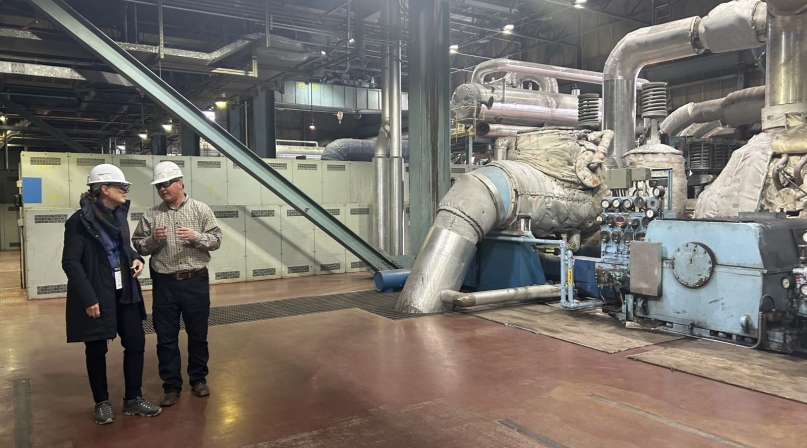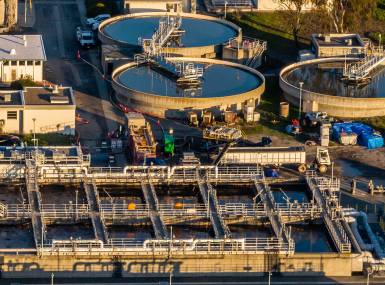BRECC explores energy transformation of the Cowboy State
Author

Kasantha Moodley
Upcoming Events
Related News

Like many coal-centric regions in the United States, Wyoming’s coal production has declined over the last decade. Home to 15 coal mines and 10 coal plants, the state still produces 41% of the nation’s coal and holds 6 gigawatts (GW) of electricity-generating capacity.
In response, the state is gearing up for a total energy transformation, “one that addresses our climate challenges and ensures investment in legacy assets and in new energy innovations and technologies,” Gov. Mark Gordon (R) told the Building Resilient Economies in Coal Communities Network — BRECC — in October. He affirmed Wyoming’s commitment to an “all-of-the-above energy strategy.”
Attendees visited Kemmerer, Lincoln County’s seat, to learn how coal community assets support energy innovation and economic diversification with the help of public-private partnerships.
The first stop was at Kemmerer’s Naughton power plant, where the coalition learned about PacifiCorp’s partnership with TerraPower, a nuclear innovation company founded by Bill Gates. This is a partnership committed to a coal-to-nuclear energy transition, through the development of the first-ever Natrium reactor technology power plant which features a 345-Megawatt (MW) sodium-cooled fast reactor with a molten salt-based energy storage system, capable of boosting the system’s output to 500 MW of power. While this site was chosen due to the planned closure of the Naughton power plant and its transmission and distribution infrastructure, several other factors were also considered.
Rita Meyer, CEO of Wyoming Energy Futures, explained that the “community has to be ready.” A ready and skilled workforce, infrastructure capacity and most of all a willingness to work together, were key factors, she said. While an investment of this magnitude ($4 billion) would significantly grow the local economy, the communities of Kemmerer and Diamondville are concerned by the upfront community investment needed for workforce housing and other services, like sewer and water infrastructure.
This chicken-and-egg dilemma is an issue that the Interagency Working Group (IWG) on Coal and Power Plant Communities and Economic Revitalization are working hard to resolve. Dru Bower, a consultant for Wyoming’s IWG’s Rapid Response Team, shared some insights into how energy-producing communities in Wyoming are learning to leverage federal dollars matched by local investors, for infrastructure improvements, among other needs.
In June, Wyoming held a federal funding summit, where 200 members of the community gathered to learn about current federal funding opportunities and how to successfully compile grant applications. More recently, the IWG in Wyoming has led the formation of a group that provides grant services to anyone who needs it. The group will support communities through grant writing and grant review services.
“Communities in Wyoming are incrementally getting into the game, reshaping their towns and livelihoods,” Bower said.
The Natrium technology demonstration project isn’t the only development that has propelled the state’s strategy of being an all-of-the-above energy state. Wyoming is also home to one of four original carbon capture, utilization and storage (CCUS) project sites, funded by the U.S. Department of Energy. University of Wyoming’s School of Energy Resources and its partners are working to develop commercial-scale geologic storage of CO₂ from industrial sources. Once fully operational, the project could store more than 50 million tons of CO₂ underground. Being an early leader in CCUS technology has positioned the state to be at the forefront of carbon capture investments. Last year, CarbonCapture announced that Project Bison, the world’s largest carbon capture plant, will locate in Wyoming.
In line with seeking innovation, the state and its partners have also embarked on research and development aimed at unlocking the full potential of coal, beyond its traditional use in energy generation. The products under development include organic fertilizers and an asphalt-like material designed for road construction, spurning new businesses.
Above-ground assets are also at the top of minds of local communities. Towns like Kemmerer are looking to unlock the potential of historic buildings, like the nation’s first JC Penney store, located in the town’s triangle. Kemmerer is also home to Fossil Basin and the Fossil Butte National Monument, sites that are world-renowned for their rich paleontology.
Wyoming, like all coal communities, is navigating a critical phase to balance historic reliance and a cultural pride of coal with the imperative for an energy-resilient and sustainable future. The state’s all-of the-above energy strategy recognizes that communities need to adapt in diverse ways and at different scales.
Related News

Congress examines PFAS liability and cleanup regulations
On December 18, the U.S. House Energy and Commerce Subcommittee on Environment held a hearing examining the current statutory and regulatory landscape for PFAS. The hearing follows a similar hearing held by the U.S. Senate Environment and Public Works Committee on November 19.
‘Fix-It Fair’ brings new life to damaged items, helps divert waste
Thurston County, Wash. partnered with a non-profit to help residents fix things that are difficult to recycle.

U.S. House of Representatives passes SPEED Act and other permitting reform bills
On December 18, the U.S. House of Representatives passed the SPEED Act (H.R. 4776). The SPEED Act would strengthen county involvement in decision-making and make needed commonsense reforms to the federal environmental review process.
Webinar
BRECC National Network: Shaping your Coal Community’s Approach to Economic Diversification
This webinar outlined a Place Value framework for creating more diverse and resilient economies. Community Builders shared how their work in the West supports developing a unique and localized economic toolbox for communities facing coal transition.
